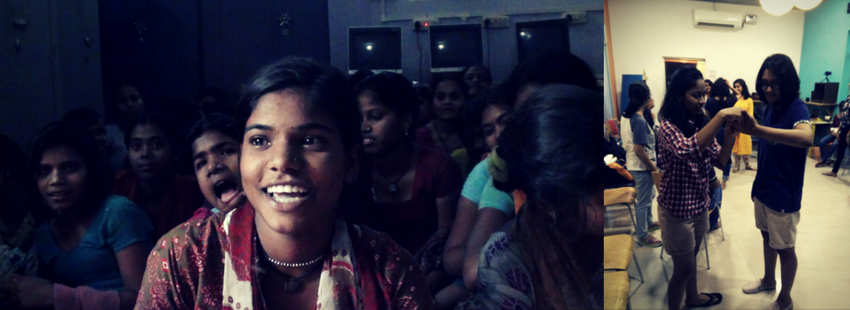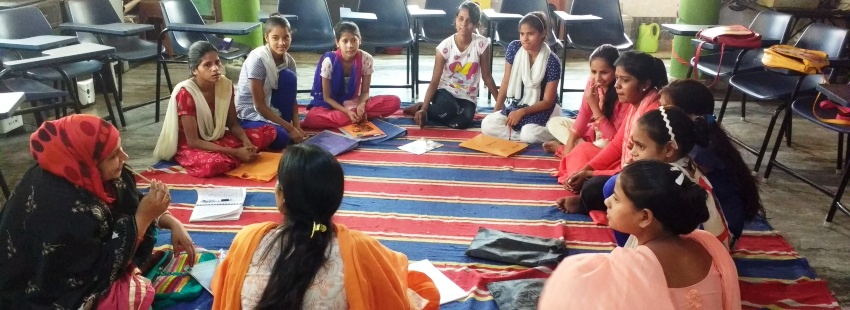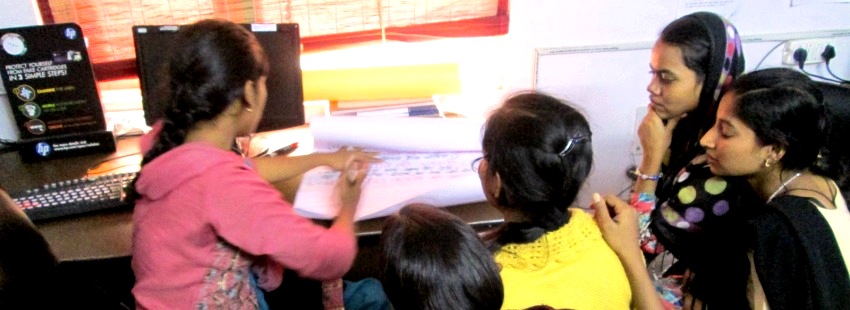Young People’s Education
Introduction
In the current context of education, several community initiatives and governmental schemes have been focusing on school-going children in the age group of 6 to 14 years. The Right to Education Act 2009 also promises access to education among all children between this age group. However, a significant number of young girls and boys above the age of 10 years are not able to avail or continue their education. Even though young adolescents, up to the age of 14 are covered under the RTE, many of them are pushed out of the schooling system due to administrative apathy, lack of quality education, lack of resources, and burden of earning a living to support their families.
Access to education, especially among young girls living in resettlement colonies or unorganised colonies, has remained a challenge over the years. Policies, schemes, and community-based work should recognise that young people, like any other social category, do not form a homogenous group and are located differently, whether in terms of gender, dis/ability, sexuality, caste, class, rural or urban, including young people who are transgender, a thus far invisible category.
Keeping such a dynamic yet unacknowledged context in mind, our work is aimed at how young people relate to the realms of school education, technology, gender, and sexuality. We seek to strengthen the process of school or non-formal education initiatives through teachers’ training, demonstrating possibilities of community involvement, research etc.
Interventions
Parvaaz Adolescents Centre for Education (PACE): To address the emerging educational needs of young girls living in urban and semi urban areas, we started structured educational intervention under the banner of Parvaaz Adolescent Centre for Education (PACE) programme in April 2015 to create access to quality education from gender and sexuality lens. It is an educational programme with a gender and sexuality perspective, run in collaboration with community-based organisations of the selected areas, for adolescent girls and young adult women (age 15-22 years). These girls are either drop outs, have never enrolled in the formal education system, or are school-going but have low levels of literacy and numeracy skills.
Tarang Centres: The age group of 10 to 14 years is uniquely placed between children and adolescents; who are beginning to assume adolescent-like responsibilities but also display children-like energy and enthusiasm. Categorically, ‘very young adolescents’ have often been clubbed together with either ‘children’ or ‘adolescents’, where their particular needs have been overlooked, especially in sexual and reproductive health programmes. In 2020, we started working with drop-out or never-enrolled Very Young Adolescent (VYA) girls and boys in North-West Delhi. The programme follows the same principles of PACE and aims to provide access to quality education to VYAs from marginalised communities through a feminist lens and bring them back to mainstream education.
Ummeed Centres: The lockdown and the school closures caused great damage to the education of girl students belonging to marginalised communities. An internal survey conducted by Nirantar, in partnership with womens’ federations in seven districts of Bihar, revealed that out of the 350 girls enrolled in classes 10 and 12, only 86 were attending online classes (based on the number of girls who participated in the survey).
Ummeed, a programme initiated by Nirantar in Bihar, engages local tutors for girls in classes 10 and 12—an idea pitched by the girls themselves. These learning centres work as bridge schools and prepare the students in subjects that they find difficult to manage on their own. The federations take the responsibility to ensure that the girls are not discouraged by their parents, and that the tutors do their job well. Today, Ummeed accommodates 12 learning centres and 152 enrolled female learners, all from landless migrant families.
Kishori Manch: To ensure inter-generational sustenance of the impact of Nirantar’s engagement, it is important that the young women and older girls also become active partners in the change process along with the adult women. Perspectives and beliefs about sexuality, desire, pleasure, socially approved behaviours, gender roles etc. may differ between young and old women, but a constructive dialogue at a common platform does help in bringing the two seemingly contrarian views closer. Nirantar has considerable experience of engagement with adolescents in urban settlements, which it is bringing into its engagement with federations. Mobilisation of adolescent girls was an entry point to build a long-term agenda for working with this constituency. Through the Adolescent Empowerment programme launched in 3 districts in 2018, federations have mobilised close to 4,500 adolescent girls from the most marginalised communities into 150 village-level collectives called Kishori Manch. These are common safe spaces for girls to voice their concerns and take collective actions against gender-based discriminatory practices.
The PACE, Tarang and Ummeed learning centres function in areas where majority of the population is from marginalised and economically-backward groups like Muslim and Dalits. The programme includes:
Curriculum Building: Under this programme, we have developed a dynamic curriculum with a feminist approach that responds to the contextual realities of the girls and boys. The key element is to build content and resources based on the learners’ context and age, in order to provide them with exciting and meaningful learning experiences. Lenses of gender, sexuality, class, caste, religion, region, age, language and disability have been integrated in the curriculum. The PACE Centres have become safe spaces for adolescent girls in urban resettlement colonies, to share experiences, aspirations, desires, build friendships, and social networks. We are currently in the process of digitising our curriculum with active involvement of learners and facilitators and we aim to provide access to online and offline versions of our curriculum to learners and facilitators across the country.
Learning Outside the Classroom: Despite living in Delhi city for many years, majority of the girls living in urban slums and rehabilitation colonies never go outside their colonies. Thematic walks, picnic and sports day are integral part of our pedagogy that provides opportunity to the learners to explore the outside world and analyse the classroom discussion through practical experiences by visiting various places like the old Delhi spice market, Old Mehrauli village, traditional baoli, Yamuna river, Hazi Ki Dargah and understanding history of Bareilly through the shrine. We collaborated with Darwesh, to conduct historical walks around Delhi on the themes that correlated with our curriculum. Interaction with local people and resource persons during these walks help in building the perspective of the learners on themes like water, market, environment, evolution of city and their relationship with the city as migrants.
Regular and Close Interaction with Parents and Community: Community engagement is an essential part of our approach; relationships are built through various community level events such as collective reading sessions, storytelling, open discussions, role-plays and movie screenings. We talk about gender and education with men, women, and community leaders. Nirantar conceptualises and implements community engagement activities in collaboration with partner organisations.
Strong Livelihoods Linkages: All the girls who complete the PACE Learning Course are given a variety of exposure and orientation, to help decide their future livelihoods options. Nirantar organises these orientations as well as on-the-job exposure for all the PACE girls across locations and centres. Additionally, we also organise career-counseling sessions to motivate them and develop a keenness to opt for work outside home. We forge collaborations with existing skill development and livelihood-based organisations.
Community Outreach: Weekly community outreach and two parent-teacher meetings have helped to establish trust with the parents of the learners, along with strengthening and broadening our work in the larger community as well.
Documentation: Our documentation process has been a crucial element of our teaching-learning approach at the centres. While the day-to-day activities are being documented by the teachers, the girls are also encouraged to regularly express their thoughts and experiences through letter writing. This part of the programme helps to accumulate and analyse the myriad experiences of life in the urban space from the perspectives of these young girls.
Capacity Building: We provide capacity building inputs to groups and organisations working with young people, staff of community-based programmes, as well as for those involved in research, training, curriculum development, monitoring and evaluation.
Advocacy: Our approach towards sexuality is positive and political, in which it seeks to build an in-depth understanding of ‘why’ sexual and gender norms and lived realities are the way they are and ‘why’ those who are seen to be challenging these norms are punished. We have also sought to generate an understanding and dialogue with governmental organisations and NGOs about the problems in which Life Skills and Adolescence Education is being approached.
Past work
Research and Interventions Regarding Early and Child Marriage: Nirantar’s engagement with the issue of early marriage probes the surface of commonly articulated reasons for child marriage, such as poverty, dowry and traditional practices. We seek to explore and analyse the nature of decisions around marriage which reinforce and reproduce structures of gender, class, caste, religion, and patriarchy.
The ‘Landscape Analysis of Early and Child Marriage in India’ initiated Nirantar’s engagement with the issue of early marriage, child, and forced marriage. We conducted a study across seven states, namely Rajasthan, Andhra Pradesh, West Bengal, Bihar, Jharkhand, Maharashtra, and New Delhi, in consultation with over 50 organisations and key informants. Through this study, we analysed the issue of early and child marriage from the lens of gender and sexuality to identify its root causes and enabling factors. We found that largely the issue has been approached from a ‘child protection’ lens. You can download the report here:
Action Research: Through our action-research project, we are exploring the possibilities of enabling empowering spaces for young people to critically understand their lived realities, using diverse methods available within the approach of participatory action research. Among these, we are focusing on the techniques from Augusto Boal’s ‘Theatre of the Oppressed’ to understand and facilitate what concerns young people, influences their desires and forms their aspirations.
Through this process, we seek to create open and safe spaces for conversations and collective knowledge building around themes of caste, sexuality, gender, religion, ethnicity, and migration that shape the everyday lives of young people and the communities they live in.
Capacity Building: We have worked closely with grassroots organisations across 6 states, namely Rajasthan, Uttar Pradesh, Andhra Pradesh, Maharashtra, Madhya Pradesh and New Delhi, to build capacities of fieldworkers working on early and child marriage. Through these intensive trainings and workshops, we seek to identify and articulate issues of gender and sexuality as part of their work with young people. We support organisations through their participation in regular institutional courses conducted by Nirantar, and through theme-based workshops designed to cater to the specific needs of each organisation, to help them address specific field-level challenges in their work with young people.
Informing Discourse: We attempt to create space for issues of gender and sexuality within global, regional, national and grassroots discourses around early and child marriage. Over the past few years, we have participated at forums such as the United Nations, specifically Committee on Status of Women, and focused on the United Nations Resolution on Child, Early and Forced marriage (CEFM). Additionally, we have called for a youth-centric approach that focuses on the ‘root causes’ of the issue at various international forums. We have also reached out to existing networks around adult education that Nirantar is a part of, to highlight the role that non-formal, adult education can play as a strategy to address issues of early and child Marriage.
Information and Communication Technology (ICT) for Empowerment: Nirantar sees empowering potential in new media, especially for young women from marginalised communities with limited formal education to challenge a social structure that restricts their lives to domesticity.
In November 2012, Nirantar, in collaboration with Sanatkada, launched its leadership programme for young Muslim women in Lucknow. We undertook capacity building on the use of technology such as computers, photography and film-making, along with perspective building on gender and identity with young Muslim, Dalit, and tribal women.
Engagement with Government and Mainstream Curriculum
- Writing for School SCERT Text Books: The government school textbooks produced post the NCERT’s National Curriculum Framework of 2000 were critiqued for containing numerous factual errors, for distorting facts and for promoting conservative ideologies. In September 2004, NCERT constituted expert groups to review and recommend changes in these textbooks. Nirantar was involved in coordinating a team of teachers and educationists to work together on the Civics textbooks for Classes 6 to 8, published by SCERT, Delhi. The aim was to write in a language that would be accessible to the learner as opposed to writing for the teacher, and to bring in concepts through narratives and experiences of the learner.
- Textbook Regimes: A Feminist Critique of Nation and Identity: Nirantar conducted a collaborative study which analysed both government- and privately-published textbooks across four states, and at the national level. As education is a state subject, the political context becomes important in order to analyse how the gender question and its intersectionalities have been dealt with by states presently espousing different political ideologies and with different political histories.
- National Curriculum Framework (2005): The year 2005 saw the drafting of the next National Curriculum Framework (NCF). Representatives from academia, the teaching community and NGOs were involved in writing focus group papers on 21 themes. These focus group papers contributed to the formulation of the NCF document. In addition to this, new syllabi based on the NCF 2005 and the first round of changes in textbooks formed part of the initiatives that mainstream education witnessed.
- Gender Focus Paper: Nirantar has been part of the Gender Focus Paper in the formulation of the syllabi for political science and in the writing and designing of the textbooks. The Gender Focus paper provides a radical departure from how the education sector has looked at gender in education till now—not merely in terms of breaking stereotypes or in terms of quantitative representation, but into the domain of disciplinary knowledge.



